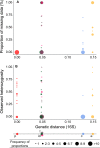Genetic diversity and differentiation in reef-building Millepora species, as revealed by cross-species amplification of fifteen novel microsatellite loci
- PMID: 28243525
- PMCID: PMC5326544
- DOI: 10.7717/peerj.2936
Genetic diversity and differentiation in reef-building Millepora species, as revealed by cross-species amplification of fifteen novel microsatellite loci
Abstract
Quantifying the genetic diversity in natural populations is crucial to address ecological and evolutionary questions. Despite recent advances in whole-genome sequencing, microsatellite markers have remained one of the most powerful tools for a myriad of population genetic approaches. Here, we used the 454 sequencing technique to develop microsatellite loci in the fire coral Millepora platyphylla, an important reef-builder of Indo-Pacific reefs. We tested the cross-species amplification of these loci in five other species of the genus Millepora and analysed its success in correlation with the genetic distances between species using mitochondrial 16S sequences. We succeeded in discovering fifteen microsatellite loci in our target species M. platyphylla, among which twelve were polymorphic with 2-13 alleles and a mean observed heterozygosity of 0.411. Cross-species amplification in the five other Millepora species revealed a high probability of amplification success (71%) and polymorphism (59%) of the loci. Our results show no evidence of decreased heterozygosity with increasing genetic distance. However, only one locus enabled measures of genetic diversity in the Caribbean species M. complanata due to high proportions of null alleles for most of the microsatellites. This result indicates that our novel markers may only be useful for the Indo-Pacific species of Millepora. Measures of genetic diversity revealed significant linkage disequilibrium, moderate levels of observed heterozygosity (0.323-0.496) and heterozygote deficiencies for the Indo-Pacific species. The accessibility to new polymorphic microsatellite markers for hydrozoan Millepora species creates new opportunities for future research on processes driving the complexity of their colonisation success on many Indo-Pacific reefs.
Keywords: Cross-species transferability; Genetic distance; Genetic diversity; Microsatellites; Millepora.
Conflict of interest statement
The authors declare there are no competing interests.
Figures

Similar articles
-
Microsatellite characterization and marker development from public EST and WGS databases in the reef-building coral Acropora millepora (Cnidaria, Anthozoa, Scleractinia).J Hered. 2009 May-Jun;100(3):329-37. doi: 10.1093/jhered/esn100. Epub 2008 Nov 28. J Hered. 2009. PMID: 19043068
-
Molecular Phylogeny Demonstrates the Need for Taxonomic Reconsideration of Species Diversity of the Hydrocoral Genus Millepora (Cnidaria: Hydrozoa) in the Pacific.Zoolog Sci. 2018 Apr;35(2):123-133. doi: 10.2108/zs170142. Zoolog Sci. 2018. PMID: 29623790
-
New microsatellite DNA markers to resolve population structure of the convict surgeonfish, Acanthurus triostegus, and cross-species amplifications on thirteen other Acanthuridae.Mol Biol Rep. 2020 Oct;47(10):8243-8250. doi: 10.1007/s11033-020-05773-0. Epub 2020 Sep 8. Mol Biol Rep. 2020. PMID: 32897521
-
Development of polymorphic microsatellite loci for conservation genetic studies of the coral reef fish Centropyge bicolor.J Fish Biol. 2015 Sep;87(3):748-53. doi: 10.1111/jfb.12694. Epub 2015 Aug 14. J Fish Biol. 2015. PMID: 26272332
-
Novel Polymorphic Microsatellite Markers for Panulirus ornatus and their Cross-species Primer Amplification in Panulirus homarus.Anim Biotechnol. 2016 Oct;27(4):310-4. doi: 10.1080/10495398.2016.1190372. Anim Biotechnol. 2016. PMID: 27565876
Cited by
-
Development of 26 highly polymorphic microsatellite markers for the highly endangered fan mussel Pinna nobilis and cross-species amplification.Mol Biol Rep. 2020 Apr;47(4):2551-2559. doi: 10.1007/s11033-020-05338-1. Epub 2020 Feb 25. Mol Biol Rep. 2020. PMID: 32095986
-
Population structure of the hydrocoral Millepora platyphylla in habitats experiencing different flow regimes in Moorea, French Polynesia.PLoS One. 2017 Mar 8;12(3):e0173513. doi: 10.1371/journal.pone.0173513. eCollection 2017. PLoS One. 2017. PMID: 28273119 Free PMC article.
-
On the occurrence of intracolonial genotypic variability in highly clonal populations of the hydrocoral Millepora platyphylla at Moorea (French Polynesia).Sci Rep. 2017 Nov 1;7(1):14861. doi: 10.1038/s41598-017-14684-3. Sci Rep. 2017. PMID: 29093527 Free PMC article.
-
Development of novel microsatellite marker sets for 5 common tropical hydrozoan species (Cnidaria: Hydrozoa) from the Southwestern Indian Ocean.Mol Biol Rep. 2024 Dec 30;52(1):91. doi: 10.1007/s11033-024-10179-3. Mol Biol Rep. 2024. PMID: 39738687
-
Naturally occurring fire coral clones demonstrate a genetic and environmental basis of microbiome composition.Nat Commun. 2021 Nov 4;12(1):6402. doi: 10.1038/s41467-021-26543-x. Nat Commun. 2021. PMID: 34737272 Free PMC article.
References
-
- Adjeroud M, Guérécheau A, Vidal-Dupiol J, Flot J-F, Arnaud-Haond S, Bonhomme F. Genetic diversity, clonality and connectivity in the scleractinian coral Pocillopora damicornis: a multi-scale analysis in an insular, fragmented reef system. Marine Biology. 2014;161:531–541. doi: 10.1007/s00227-013-2355-9. - DOI
-
- Baird AH, Guest JR, Willis BL. Systematic and biogeographical patterns in the reproductive biology of scleractinian coral. Annual Review in Ecology, Evolution and Systematics. 2009;40:551–571. doi: 10.1146/annurev.ecolsys.110308.120220. - DOI
LinkOut - more resources
Full Text Sources
Other Literature Sources
Research Materials

